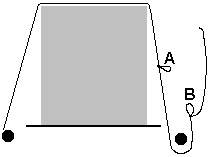| HOME | Versatackle |
 |
 |
|
 | ||
At both "A" and "B", put the loop of your choice. I prefer a Butterfly Loop or Span Loop for making a loop on the bight. Take the extra rope coming from B and pass it through loop A, then back through B, then A, then B. Go through each loop the same direction each time for best results. For example, in the first diagram, the free end would always be circling clockwise between the two loops.
Typically, you pull the free end through each loop two or perhaps three times, depending on the rope and the situation. As mentioned before, it is self-locking, meaning that just by pulling the free end and letting go, the Versatackle's internal friction will hold the load.*
Use it for binding, clamping, pulling or whatever. The downside is that it can cause premature rope wear. If you're tying down a load on a truck, tie the butterfly a few feet off the bed, loop the rope down around a hook, and tie another butterfly with plenty of extra rope, as shown in the second diagram. You can figure out the rest from there. This concept is easily adapted to various uses.
You can also gain mechanical advantage with a rope in a little more involved method called the Spanish Windlass. With fewer tucks, the Versatackle can be used to lower a heavy load. The Versatackle has a high mechanical advantage, so occasionally feel the ropes as you tighten things to avoid applying too much force. If you often use the Versatackle for the same task, leave the loops tied in the rope to save time.
________________________________________________________________
*It's always good practice to tie off the free end of the Versatackle to keep things tidy, even if you don't think it needs the extra security.
There are scores of tie-down systems loosely referred to as Trucker Hitches which only use one loop on the bight, and are tied off with a slipped half hitch or the like since they are not self-locking. Since they only simulate a single-pulley system, they do not develop much tension, and the tension that is developed is partly or mostly lost in the process of tying off, depending on the dexterity of the tyer. If you decide to use such a system, be sure you familiarize yourself with decent loops on the bight, such as the Butterfly Loop, Span Loop, or Farmer's Loop.